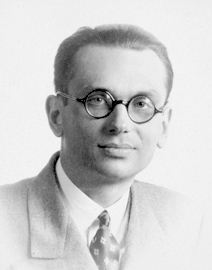Humanity’s search for God, along with the endeavor to represent God symbolically, is a cultural universal that is older than civilization itself. Calling out to the silent stars for an Everlasting Light, our species has sought to grasp the Transcendent through symbols since before the dawn of written language. Constructed nearly 8000 years before the Great Pyramids, “the faceless, counterintuitive, T-shaped monoliths of Göbekli Tepe can readily be understood as representations of powerful, supernatural beings.” Here, solemn inscriptions, whose meanings are now long lost, testify to the beginnings of our iconographic endeavors to capture the mysteries of the heavens. The search for God through symbols that began at Gobekli Tepe would continue through numerous philosophical traditions to become expressed ultimately in the formal language of mathematics.
Faith Seeking Logical and Mathematical Understanding
About 1500 years ago the Christian mathematician, physicist, theologian, and philosopher John Philoponus (490 to 570) was the first to use detailed mathematical arguments to make a case for the existence of God. Striving to demonstrate the logical consistency of the Christian faith to the pagan philosophers of his day, Philoponus discovered a deep contradiction at the heart of Aristotle’s argument for the eternity of the world that opened a path to a mathematical case for the Christian concept of a creator God. Philoponus proposed a simple and logically consistent argument: (1) Whatever comes to be has a cause of its coming to be; (2) The universe came to be; (3) Therefore, the universe has a cause of its coming to be. Through a variety of subsequent arguments Philoponos argued that this transcendent cause of the universe is God.
The medieval tradition of faith seeking understanding, exemplified by Anselm of Canterbury (1033-1109), Bonaventure (1217-1274), and Thomas Aquinas (1225–1274) inherited and further developed the arguments of Philoponus. Anselm also constructed a novel type of proof for the existence of God, known as the “ontological proof”, which aims to demonstrate that God’s existence is logically entailed by the very concept of God. Natural philosophers such as Johannes Kepler (1571-1630), Rene Descartes (1596-1650), Isaac Newton (1643-1727), and Gottfried Leibniz (1646-1716) further elaborated the proofs with regard to their mathematical formulation and logical consistency. Leibniz, the “founder of computer science” who invented both calculus and binary code, continued to refine Anselm’s ontological proof, arguing that 1) a Most Perfect being [aka God] is Possible, and 2) If God is possible, then God exists.
Gödel’s Quest for God

Mathematician Kurt Gödel
The tradition of faith seeking mathematical understanding continued for 400 years until it was taken up by another mathematician and philosopher, Kurt Gödel. The most brilliant and influential mathematician of the 20th century, Gödel was famous for proving mathematically that all mathematical systems are incomplete and that every mathematical system will have some statements that can never be proven. Gödel’s incompleteness theorems show that if a formal system is 1. finitely specified, 2. large enough to include arithmetic and 3. consistent, then it is incomplete. Gödel’s momentous demonstration — that all mathematical systems have limits — was a lesson in epistemic humility to the Logical Positivists of Gödel’s day who asserted that scientific and mathematical investigations of the universe can discover all truths and have no limits. Gödel showed that if science is based on mathematics; and mathematics cannot discover all truths; then science, in principle, cannot discover all truths.
In addition to demonstrating the incompleteness of all mathematical systems, Gödel also believed that the universe would be incomplete, and inconsistent, without an afterlife and a creator God. Gödel reasoned:
If the world [Welt] is rationally constructed and has meaning, then there must be such a thing [as an afterlife]. For what sense would there be in creating a being (man), which has such a wide realm of possibilities for its own development and for relationships to others, and then not allowing it to realize even a thousandth of those [possibilities]? That would be almost like someone laying, with the greatest effort and expense, the foundations for a house, and then letting it all go to seed again.
But does one have reason to suppose that the world is rationally constructed? I believe so. For it is by no means chaotic or random, but, as science shows, everything is pervaded by the greatest regularity and order. Order, however, is a form of rationality [Vernünftigkeit].
How would one envision a second [another] life? About that there are naturally only guesses. However, it is interesting that it is precisely modern science that provides support for such a thing. For it shows that this world of ours, with all the stars and planets in it, had a beginning and most probably will also have an end (that is, it will literally come to “nothing”). But why, then, should there exist only this one world—for just as we one day found ourselves in this world, without knowing why and wherefrom, so can the same thing be repeated in the same way in another world too. In any case, science confirms the apocalypse [Weltuntergang] prophesied in the last book of the Bible and allows for what then follows: “And God created a new Heaven and a new Earth.”
Within the context of faith seeking understanding, Gödel developed a mathematical proof to demonstrate God’s existence. Viewing himself as a successor to Leibniz, Gödel’s proof elaborated upon the ontological proof of his predecessor. Gödel sought to fix the fundamental weaknesses of and remove inconsistencies from Leibniz’s proof. Gödel’s proof addresses all of the classic philosophical criticisms of Anselm’s, Descartes’, and Leibniz’s ontological proofs, and also addresses Kant’s well-known objection that existence should not be treated as a predicate.
Gödel’s ontological proof uses mathematical logic to show that the existence of God is a necessary truth. “God” in Gödel’s proof is defined as a “Godlike object”. In order for an object to be “Godlike”, it must have every good or positive property. Also, a Godlike object has no negative properties. In the context of Gödel’s proof, an object (x) has “the Godlike property” if and only if for every property (φ), if φ is a positive property, then x has property φ. Because being “Godlike” is a positive property, it is possible that that property exists in an object (x). After mathematically defining essential or necessary properties Gödel then shows that it is necessary that there is an object x that has the Godlike property. If a Godlike object (i.e. God) has every good property, and necessary existence is a good property, then a Godlike object (i.e. God) must exist.
While Gödel privately believed in God, and even read the Bible every Sunday, fear of ridicule from his academic peers made him reluctant to present his ontological proof publicly. Gödel thus never published his proof for the existence of God, and only passed it onto a colleague and friend because he believed he was going to die.
In time, the fruit of Leibniz’s binary theory, AI, would demonstrate the consistency of Gödel’s ontological proof. One team of AI researchers concluded that “From Gödel’s premises, the computer proved: necessarily, there exists God” and also that “this God-like entity is unique, i.e. monotheism is a consequence of Gödel’s theory.” Such experiments, the researchers declared, “strikingly demonstrate the potential benefits of a computational metaphysics…in which humans and computer programs join forces in order to settle philosophical disputes,” thus fulfilling “Leibniz’s vision known as ‘Calculemus!’” Yet, the results of such AI calculations about metaphysics still rely on fundamental assumptions regarding the mathematical axioms that one assumes in the first place. Thus, the only weak point in Gödel’s ontological proof for the existence of God would appear to be Gödel’s own incompleteness theorems proving the limited and unprovable nature of all mathematical endeavors. But this, of course, would come as no surprise to Gödel.
Dr. Joshua M. Moritz teaches astronomy, biology, and physics at the St. John Chrysostom Academy in Bethlehem, PA. He has authored numerous books and articles, including Science and Religion: Beyond Warfare and Toward Understanding and The Role of Theology in the History and Philosophy of Science.
